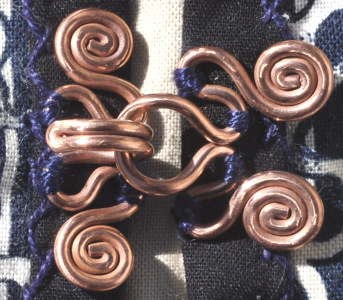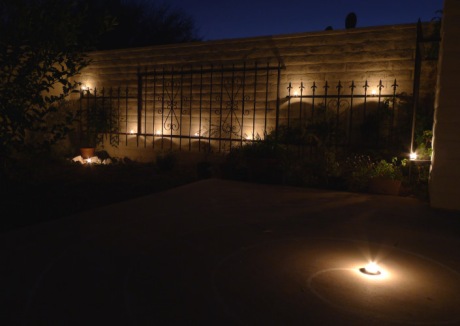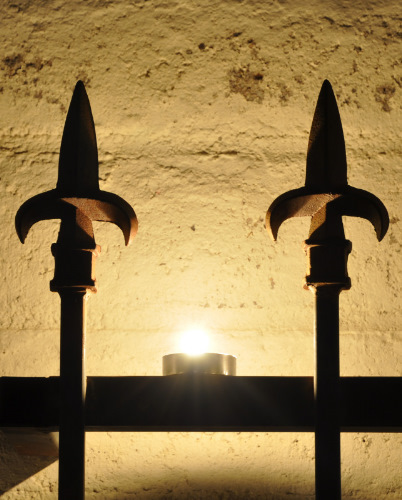Embroidered Patchwork Vest
November 25, 2011
I recently finished this vest which had been an intermittent evening project for several months. I love vests but it is difficult to find one that fits properly, since I have such a short back. It took me three paper drafts and two muslin ones to get this pattern just right, but it was worth the trouble and I still finished the pattern in one evening. It looks like a short bolero but the hem sits precisely on my waist and the whole thing is a perfect fit. The front is wider than the back (not the other way around, like a man’s vest) and the shoulders are wide enough to fit without slipping, even over my usual drop-shouldered dresses.
The vest is brown 100% linen, lined with teadye cotton muslin and bound with black/indigo batik quilter’s cotton. The binding is entirely handstitched. The shoulders and side seams are reinforced with commercial black bias tape, embroidered with french knots. Bias tape (overlain with woven running stitch in several shades of blue) was also used to bind the white/indigo calico that I used for the center stripes. The linen fabric is not a very tight weave so it’s rather unstable and needs the tape for a good fit. Most of the applique patches are from the “blue tiger” and “cat skull” fabrics that I had printed at Spoonflower, so they are my own designs. The indigo wave and charcoal bird fabrics are Japanese dobby cloth. There are a couple of flannel scraps and some vintage 1970s trim (peach/brown/white on black). On the back is half of a crocheted disk that is positioned to look like the moon rising over the waves. I picked up a bag of these round crocheted pieces (somebody’s abandoned unfinished table runner or something) at a thrift shop about 20 years ago. I made the front clasps from 14-gauge copper wire; they will look much nicer once they’ve tarnished. I thought they might be a bit heavy but they work fine. Each side is designed to be stitched down at four points for stability. They are slightly oversized for durability and ease of use.
Umber and indigo – used together, often with black and/or deep grayish-purple, are my personal “shaman’s colors”. Indigo is paired with dark brown in several traditional and/or ceremonial textiles around the world, such as Japanese clothing, Batak ikat weavings from Sumatra, and old Zuni mantas from New Mexico. It would be easy to say that this is just because these two colors are common in naturally-dyed fabrics everywhere, but there seems to be a bit more to it than that, since the same pattern (brown with a blue border, or vice versa) seems to turn up over and over in “special” garments that have been lavished with extra work, even though they aren’t brightly colored. The blue/brown combination also occurs in nature in several creatures that are both common and conspicuous, such as Steller’s jay (western U.S.), the blue tiger butterfly (Asia), and the pipevine swallowtail (U.S.).

Embroidered Patchwork Vest, Front

Embroidered Patchwork Vest, Back

Copper Clasp
Halloween 2011
November 2, 2011
We spent Halloween in the backyard, lighting candles in memory of our two cats that died this year (and entertaining the ones who are still with us, since they were watching through the screen porch).
A couple of weeks ago we salvaged 11 sets of iron security bars from the windows of an old house in Tucson. Since they were still on the house and we had to remove them ourselves, they were very cheap. We bolted them on both sides of the wall around the backyard to use as trellises for various types of potted vines. We had already done this with some of the bars from our own windows and liked the look. So now the garden walls are pretty much covered in various styles of decorative bars. Most of the new ones are painted white, and the ones from our windows are black.
The citrus/hummingbird garden is becoming a “cat garden” as well. It’s walled on three sides and parallels the cat porch, with a concrete patio separating the garden from the porch. The cats can watch the hummingbirds, butterflies, and lizards, and we can look at the colorful plants. For Halloween, we set tealight candles on the bars to illuminate the whole garden. The candle on the bottom right in the photo below is sitting at the center of a small labyrinth that I drew on the concrete with chalk.

Halloween Garden, west wall
Photo below shows one of the new sets of bars, temporarily hung with cat masks. Two candles sit on decorative boulders for Midnight Louie and Lin who are buried there. My medicinal yerba mansa patch is in the corner, below a large steel plant pot that I converted to a bell and suspended from the wall. Obviously it’s all much more colorful in daylight, although the flowers are mostly gone and the garden has a wintry look.

Halloween Garden, east and south wall

Iron Bars with Candle
